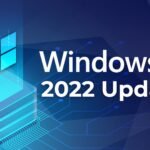In the run-up to August Patch Day, Microsoft is releasing a new maintenance update for Windows 11 22H2. The (still) optional KB5028254 patch does not bring any new functions, but instead a large number of improvements and bug fixes – for VPN, audio, and brightness.
KB5028254: Early installation possible
With patch KB5028254, Microsoft upgrades Windows 11 22H2 to build 22621.2070. Tested in advance in the Insider channel, the update is still considered a preview and therefore optional. The download must therefore be initiated manually via the Windows update function. An automatic installation will take place on the upcoming patch day on August 8, 2023.
The innovations are the same as those of the update for Windows 11 21H2 that was released at the same time. These include issues with missing display and audio devices after hibernation and excessive ARP requests when using Virtual Private Networks (VPN). In addition, Microsoft optimizes the brightness settings and fixes bugs with widgets that unintentionally detach from the taskbar.
Below you will find the detailed patch notes of the latest Windows 11 22H2 update. In addition to the highlights mentioned at the beginning, the expansion of the handwriting software input panel (SIP), fixes for excessive power consumption of the Windows notification platform, and inconsistent reporting of the L2 cache on various processors stand out.
Highlights von Windows 11 22H2 Build 22621.2070
- With this update, the brightness settings become more accurate.
- This update fixes an issue affecting certain display and audio devices. They are missing after your system is restored from hibernation.
- This update fixes an issue affecting widgets. They detach from the taskbar when you don’t expect them to.
- This update resolves an issue affecting virtual private networks (VPN). There may be excessive ARP (Address Resolution Protocol) requests to the network gateway. This occurs when the VPN is on a wireless mesh network that uses an aggressive throttling algorithm. Because of this, network performance is poor.
More improvements
- New! This update affects the Handwriting Software Input Panel (SIP), the Handwriting Engine, and the Handwriting Embedded Inking Control. They now support GB18030-2022 Conformance Level 2. This means they meet Level 3 requirements.
- This update fixes an issue in the Windows notification platform. The problem affects the power consumption of your device.
- This update affects the Windows Push Notification Services (WNS). It makes the connection between the client and the WNS server more reliable.
- This update fixes an issue affecting hybrid-connected devices. You cannot log into them if they are not connected to the internet. This occurs when using a Windows Hello for Business PIN or biometric credentials. This issue applies to a cloud trust deployment.
- This update affects Windows Autopilot profiles. Windows Autopilot policy download process is more stable. This is useful when a network connection may not be fully initialized. The update increases the number of retries when trying to download the Windows Autopilot profile.
- This update fixes an issue affecting event forwarding subscriptions. Adding an event channel to the subscription forwards events you don’t need.
- This update resolves an issue affecting the Windows Management Instrumentation (WMI) repository. This causes an installation error. The problem occurs when a device is improperly shut down.
- This update fixes an issue affecting certain CPUs. There is inconsistent reporting of the L2 cache.
- This update improves the hints for some letters of the Verdana Pro font family.
- This update affects user-mode printer drivers. You will be discharged unexpectedly. This occurs when you print from multiple print queues to the same printer driver.
- This update affects text input controls in XAML and browser controls. You cannot make text input controls editable again after they become read-only. This occurs when using the new Microsoft Input Method Editor for Japanese, Chinese, and Korean.
- This update causes the Narrator to display a “Change Product Key” notice.
- This update fixes an issue affecting the Defender Firewall profile. It cannot automatically switch from a trusted LAN to a public network.
- This update brings the COSA (Country and Operator Settings Asset) profiles up to date.
- This update fixes an issue affecting a print job. An unexpected change in Internet Printing Protocol (IPP) mode can cause the print job to be abruptly terminated. This occurs when an IHV (Independent Hardware Vendor) driver is present.
- This update resolves an issue affecting certain wireless wide area network (WWAN) devices. A dialog box will appear after each reboot. It will prompt you to switch to an embedded SIM (eSIM) even if you choose “No”.
- This update fixes a blockage in Internet Protocol Security (IPsec). If you configure servers with IPsec rules, they become unresponsive. This issue affects virtual and physical servers.
- This update fixes an issue affecting the MPSSV service. The problem causes your system to reboot repeatedly. The halt error code is 0xEF.
- This update affects the Windows kernel vulnerable driver blocklist, DriverSiPolicy.p7b. It adds drivers vulnerable to Bring Your Own Vulnerable Driver (BYOVD) attacks.
- This update fixes an issue affecting Windows Defender Application Control (WDAC). The issue copies unsigned WDAC policies to the Extensible Firmware Interface (EFI) disk partition. This partition is reserved for signed policies.
- This update fixes an issue affecting WDAC. The Disabled: Script Enforcement option can generate audit events that you don’t need.
- This update fixes an issue affecting the fastfat file system driver. It stops responding due to a race condition.
- This update resolves an issue affecting I/O over Server Message Block (SMB). Errors may occur when using the LZ77+Huffman compression algorithm.
Digital marketing enthusiast and industry professional in Digital technologies, Technology News, Mobile phones, software, gadgets with vast experience in the tech industry, I have a keen interest in technology, News breaking.
